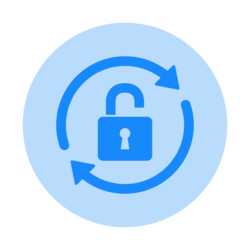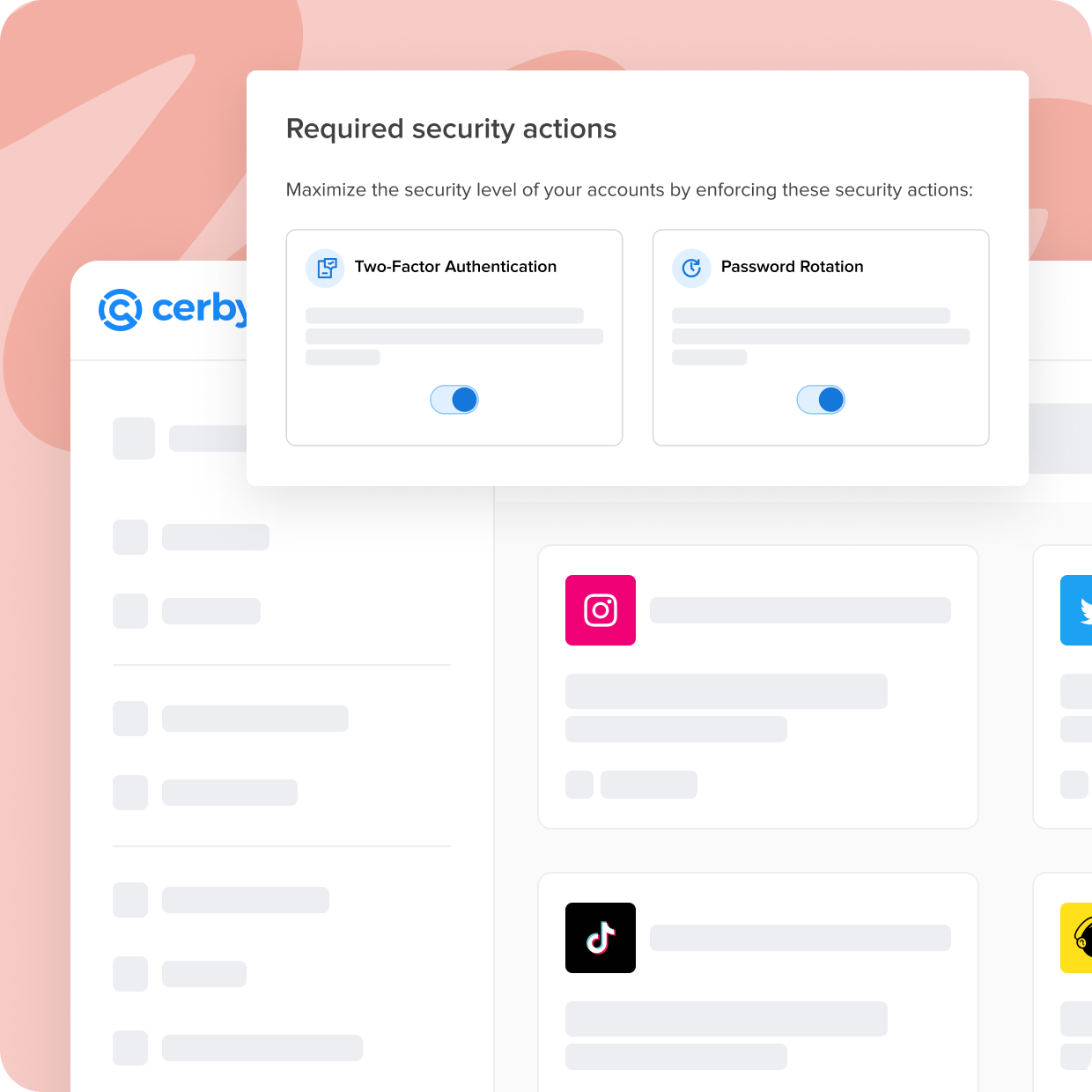Sharing passwords is often necessary, but it can be risky. Why? When passwords for an account are shared, it typically means that two-factor authentication (2FA) is disabled. Unfortunately, many corporate applications don't support shared accounts. The applications that fall into this category are best called "unmanageable." Unmanageable applications are a new category that is becoming increasingly challenging for businesses to manage and secure effectively, yet increasingly critical for businesses to succeed.
Cerby allows you to securely share access to any application, even if it's not supported by your IT team. In this guide, you'll learn the best way to share passwords, the challenges, and the players.
Securely Share Access To Any Account
Not all apps are created equal. Some come with security gaps and complexities that can hinder user adoption and put sensitive data at risk. With Cerby, you can ensure secure and seamless access to all your applications.
With Cerby You Can

Get your team connected securely

Share logins without sharing passwords

Secure 3rd party access
Safely Share Passwords
When it comes to managing passwords, it's not just about creating strong and unique passwords for each account; it's also about sharing them securely. Safely sharing passwords is crucial to protect your personal information and prevent unauthorized access to your accounts. Whether you need to share a password with a family member, a colleague, or a service provider, there are ways to share passwords securely online.
When sharing passwords, always use secure methods and dedicated tools like password managers. Although password managers are a good way to share passwords, they are not without limitations. In a study by the Ponemon Institute, they found that recent password manager breaches negatively impacted enterprise decisions to use them moving forward. One of the best ways to do this is by using a password manager, which encrypts your login credentials and allows you to share them securely with trusted contacts. Examples of password managers include LastPass, Dashlane, and 1Password. These platforms ensure that your passwords are stored securely and that you can share them with others without compromising your account's security.
Another method to safely share passwords is by creating an encrypted document or ZIP file that requires a password to open. This ensures that only the intended recipient can access the login credentials and protects the password from interception or phishing attacks.
You can also use a password-protected file-sharing service, such as Dropbox or Google Drive, to safely share passwords. However, it's important to choose a reputable service provider that offers secure file transfer and encryption.
Whether you choose a password manager or an encrypted file-sharing method, make sure to educate yourself on how to safely share passwords online to prevent identity theft and keep your online accounts secure.
One Time Secret
Sharing passwords securely is essential to protecting online accounts. A one-time sharing option such as a one-time password share or a one-time link generator can provide an extra layer of security. These tools allow users to create a unique piece of information that can be used only once to access an account.
Similarly, using a one-time password link to send passwords securely via email or text message is another popular and secure option. Password managers such as LastPass also allow users to generate secure passwords and share them safely. Encrypted email services like ProtonMail provide secure communication channels for sending passwords, and password-sharing services like SecretSafe offer an alternative method for secure sharing.
Regardless of the option you choose, it is important to ensure that shared passwords remain protected. With the many tools and services available for secure password sharing, it's easier than ever to share passwords without exposing them to significant risk.
Password Sharing Apps
In recent years, several password sharing apps and services have emerged to help individuals and organizations securely share passwords. These tools provide easy and convenient methods of collaborating securely. Here is an overview of some of the most popular password sharing websites:
LastPass
LastPass is a well-known password sharing app that offers a wide range of features, including the ability to generate complex passwords, store and share logins, and a secure browser. It offers both free and paid versions, making it accessible to a wide range of users.
Dashlane
Dashlane is a password manager that allows users to safely store and share passwords, as well as other sensitive information like credit card details and online receipts. It offers a free and premium version and supports multiple devices.
1Password
1Password is a popular password sharing service that provides users with a secure vault to store passwords and other private information. It supports two-factor authentication and provides a user-friendly dashboard.
Password sharing apps and services provide simple and secure ways to share passwords, ensuring that sensitive information remains protected. While some apps may require a fee, many of them offer free versions or trials, making them accessible to all kinds of users.
Best Way To Share Passwords With The Team
Sharing passwords within a team can be necessary for work-related tasks, but it can also create opportunities for security vulnerabilities. One best practice for securely sharing passwords within a team is to establish a password sharing policy. This policy should include guidelines for password sharing methods and rules for creating strong, unique passwords.
Password sharing links are similar to one-time passwords, but a secure link is generated instead of a password, allowing access to the online account. Methods like these help to protect passwords and reduce the possibility of data breaches.
Using a password manager can also make it easier to securely share passwords within a team. A password manager generates and stores complex, unique passwords that are difficult to crack. These passwords can be shared securely with team members, eliminating the need for employees to remember complex passwords.
Proper password management is crucial in professional environments. All users should update their passwords frequently and never reuse them across multiple accounts. Passwords should be secure, containing a minimum of 12 characters with a mix of upper and lowercase letters, numbers, and special characters. Organizations should also encourage employees to refrain from writing their passwords down, and instead use a secure password manager or a password-protected document. This measure can help ensure that passwords remain confidential, and can reduce the possibility of data breaches. It's also important to reinforce good password habits, such as avoiding low-security methods of sharing passwords and updating passwords frequently.
How To Send Passwords Securely Via Email
Sharing passwords via email can expose your sensitive login information to numerous risks. If the emails are intercepted or hacked, your password-protected accounts can easily be compromised, leading to identity theft, cyber fraud, and many other security issues. It is usually best to avoid the risks of sharing passwords via email altogether.
However, in some cases, sending login credentials via email might be necessary. In such cases, users must be careful and take specific precautions to ensure that their passwords are sent and received securely. To send passwords securely via email, users can follow some simple tips and best practices.
Avoid sending login credentials in plain text. Instead, utilize password management apps to encrypt and store passwords securely.
Copy and paste your login information into the email to avoid the possibility of typos. To attach your passwords, you can also use more secure options like password-protected PDF files or encrypted ZIP files. This tactic protects the passwords and other sensitive information during transmission and storage.
Use the "Forgot password" feature on the login page. Many websites have this feature, which sends you a password reset link to your email. If you need to share this reset link with another party, copy the link and then send it via email instead of forwarding the original “reset password” email from the respective service provider.
How to send passwords securely via Outlook
There are many ways to learn how to send passwords securely via email. Outlook users on Windows devices can encrypt emails using S/MIME, which provides end-to-end encryption for Outlook messages. S/MIME requires both the sender and the receiver to have a digital certificate through a third-party certification authority.
How to send passwords securely via Gmail
Similarly, Gmail offers TLS security, which encrypts users' email data when it's transmitted to and from Google's servers. Furthermore, Gmail suggests its users use a temporary password in cases where they absolutely have to send an address and password via email. Sending passwords via email is a risky process that should be avoided whenever possible. Users should always remain vigilant and employ best practices to send login credentials securely via email, which helps to protect against cyber threats.
Best Way To Share Passwords With Family
Today, nearly everyone creates numerous online accounts that require passwords and security questions; for many people, it can be difficult to keep track of each and every password. Fortunately, password managers can solve this problem by providing an easy way to store and manage passwords.
Free password managers for families are a great option for family accounts. Not only can these password managers store passwords, but they can also securely share them among family members. To securely share passwords among family members, it’s a good idea to use one of the best free family password managers.
Choosing a password manager that uses encryption and has a strong reputation for security is essential. Once your password manager is installed, the next step is to create a shared family account. This will allow all members to have access to the stored passwords. It’s also important to set up two-factor authentication, which can provide an extra layer of security.
Creating unique and complex passwords is essential, especially when it comes to highly sensitive accounts such as banking, email, and social media accounts. Using two-factor authentication is another way to enhance the security of these types of accounts.
By using a free password manager for family, you can make it much easier to manage passwords securely. It’s essential to select a well-vetted password manager and follow all best practices to ensure that your family’s security and privacy are protected.
